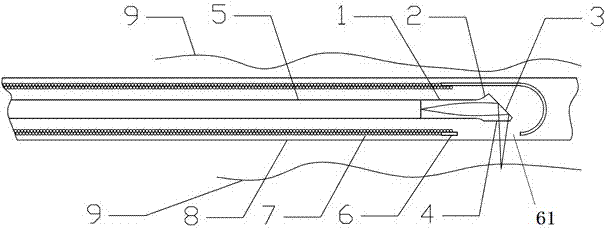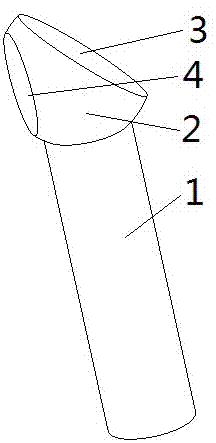OCT endoscopic imaging probe and manufacturing method thereof
A technology of imaging probe and manufacturing method, which is applied in the field of probe, can solve problems such as decomposition, attenuation, and influence of infrared spot quality, and achieve the effect of optimizing focus
- Summary
- Abstract
- Description
- Claims
- Application Information
AI Technical Summary
Problems solved by technology
Method used
Image
Examples
Embodiment Construction
[0029] The present invention will be further described below in conjunction with the accompanying drawings and specific embodiments.
[0030] Such as figure 1 As shown, an OCT endoscopic imaging probe includes a self-focusing optical fiber 1, the light-emitting end of the self-focusing optical fiber 1 is connected with a ball lens 2, and the ball lens 2 is provided with a reflective surface 3 and is connected to the reflective surface 3. Corresponding to the light exit window 4, the light emitted by the self-focusing optical fiber 1 is emitted through the light exit window 4 under the reflection of the reflective surface 3. The size of the reflective surface 3 is preferably capable of completely reflecting the speed of light, so The size of the light output window 4 is to meet the requirements of the light aperture, the reflective surface 3 and the light output window 4 are both plane, and the OCT endoscopic imaging probe can perform imaging work in the blood vessel wall 9 . ...
PUM
 Login to View More
Login to View More Abstract
Description
Claims
Application Information
 Login to View More
Login to View More - R&D
- Intellectual Property
- Life Sciences
- Materials
- Tech Scout
- Unparalleled Data Quality
- Higher Quality Content
- 60% Fewer Hallucinations
Browse by: Latest US Patents, China's latest patents, Technical Efficacy Thesaurus, Application Domain, Technology Topic, Popular Technical Reports.
© 2025 PatSnap. All rights reserved.Legal|Privacy policy|Modern Slavery Act Transparency Statement|Sitemap|About US| Contact US: help@patsnap.com


